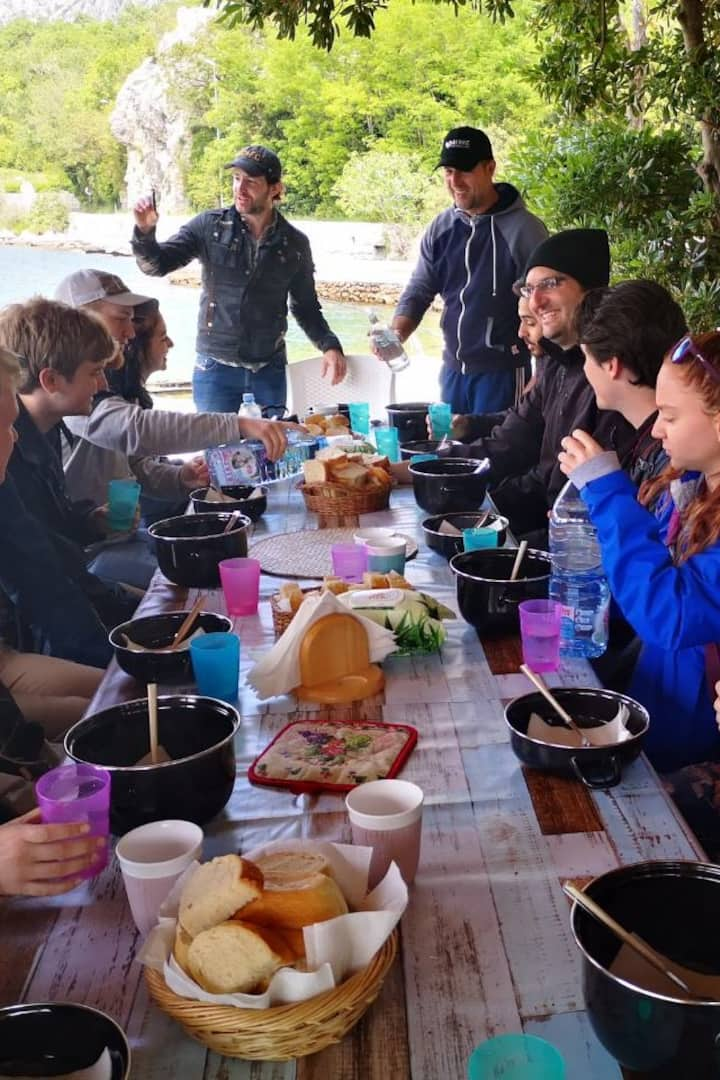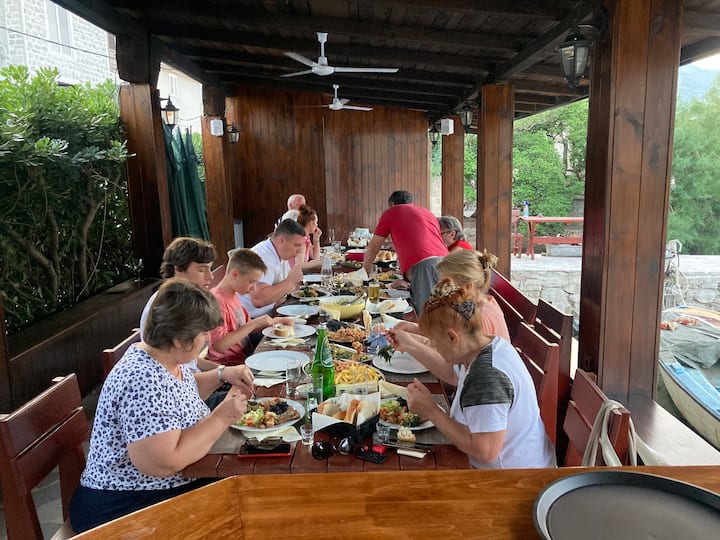Σημείο ενδιαφέροντος
Kotor
352 ντόπιοι το προτείνουν,
Συμβουλές από ντόπιους
A town over 1000 years old whit an amazing history.St.Triphon Catedral,Meritime Museum etc...
City that is centuries old, with many historical and cultural gems that everyone should visit sometime in their life.
Kotor is located at the end of Boka Kotorska (Bay of Kotor) where the Mount Lovcen and the sea cuddle the town. Kotor is a town which belongs to a very “young” country, Montenegro, even though founded in 2006 as an independent country, the area has a deep and unique history and cultural richness dating back to Neolithic ages. Kotor is an excellent combination of natural, cultural and historical beauties which makes the town worth visiting even more than once in a life time. For being close to the highlights of Montenegro such as Lake Skadar, Porto Montenegro and Budva, Kotor and the Old Town of Kotor are the pearls of Adriatic.
Kotor is located at the end of Boka Kotorska (Bay of Kotor) where the Mount Lovcen and the sea cuddle the town. Kotor is a town which belongs to a very “young” country, Montenegro, even though founded in 2006 as an independent country, the area has a deep and unique history and cultural richness dat…
Old town Kotor Powerful city walls frame the historical heart of the town, stretching along the edge of the hill St. Ivan to its peak – its highest strategic point. The walls grew successively together with the city. It is not known when their construction started. The oldest parts are those that along the northern gate, to the river Škurda and in the southwestern part by the sea. Their vertical structure was reinforced later, when firearms started to be used, with sloping buttresses on the outside. As of the 15th century Kotor became a border city, and, because of the constant threat of Turkish attacks, walls were expanded and strengthened, and the north door was built (1540), the western door was reconstructed (1555) and southern door next to the spring and bastion Gurdić was reinforced. By the sea and along the river Škurda, several bastions were built with towering Citadel. The walls were built until the 19th century, particularly their upper part. Within them, on the slope of the hill, there is the church of Our Lady of Health, called also Our Lady of Rest, which was used for the rite of the military garrison of the upper fortress. The oldest recorded archaeological building within the city is the early Christian basilica from the 6th century which was found beneath the present church of Maria Collegiate. It was, apparently, an abbey, which indicates that Kotor was already a significant urban settlement and episcopal city. At the beginning of the 9th century, the city got its patron – St. Triphun (in the local language - Tripun), to whom the Memorial Church was dedicated in the year 809. A more intense urban development can be traced only from the 12th century. It is only then that a new big cathedral was built (1166), then numerous Romanesque churches - St. Luka (1195), Maria Collegiate, (1221), St. Ana (early 13th century), St. Paul (1263) and some other unsaved churches. As for the Gothic buildings the palace Drago singles out as well as the ruins of refurbished palaces of Buća and Bizanti, as well as numerous remains of architectural sculptures - portals, trifora (multiple arched windows), bifora (semi-circular headed windows) and other relief ornaments. Apart from the local builders, stonemasons and sculptors, special place belongs to Franciscan Vito from Kotor - builder of the Monastery Dečani. Masters from other coastal cities and even occasional foreigners worked in the city of Kotor as well. As for the craftsmen there were remarkable jewelers, whose products were widely known, and some of them also worked in other countries. Among their art and craft creations - religious, votive and luxury - which are kept in the treasury of the cathedral and other churches, special place belongs to the gilded silver pala in the cathedral. During the 13th and 14th centuries, a group of painters worked in Kotor, known in the history of arts as pictores graeci. Written sources of the archives of Kotor record the names of Nikola and Manojlo at the beginning of the 14th century and Georgije at the end of the 14th century. Some of those “Greek” painters painted the frescoes in the cathedral and Maria Collegiate of which only fragments are preserved. Little did it get to this day from the greatest of all the painters of Kotor - Lovro Marinov Dobričević, who is attributed frescoes in the church of St. Ana and picture on the board in the Cathedral with the Virgin Mary and Christ, on one side, and Ecce Homo, on the other side. The Baroque style is the style of many other churches built in that time (St. Joseph, Our Lady of the Angels, St. Ghost), Palaces (Pima, Grubonja, Grgurina) and city houses, while numerous structures, sacral and profane, were redone in baroque style. The needs for paintings and sculptures were mainly meet through the import from Venice. In the city only a few local artists worked such as Fra Deziderio Kotoranin, or foreign artists such as Francesco Cabianca, the Venetian sculptor, who in the early 18th century made his greatest works in the very city of Kotor. The last major construction projects within the urban core of the city of Kotor were executed in the times of the Austro-Hungarian administration when, in the late 19th and early 20th century, several buildings were built, public and private, in the spirit of secession, which do not fit into the urban core of the ancient town of Kotor in the best possible way. Because of authenticity and general cultural and historical values as the eternal link between the Mediterranean and the Balkan hinterland, Kotor is on the UNESCO’s list as part of the World Natural and Cultural Heritage.
Old town Kotor Powerful city walls frame the historical heart of the town, stretching along the edge of the hill St. Ivan to its peak – its highest strategic point. The walls grew successively together with the city. It is not known when their construction started. The oldest parts are those that a…
Kotor is a coastal town located in a secluded part of the Bay of Kotor. The old Mediterranean port of Kotor is surrounded by impressive fortifications built during the Venetian period and the Venetian influences can be seen in the old town architecture which is one of the best preserved medieval old towns in the Adriatic and is a UNESCO world heritage site. The Bay of Kotor (Boka Kotorska), one of the most indented parts of the Adriatic Sea. Some have called it the southernmost fjord in Europe, but it is a ria, a submerged river canyon. Together with the nearly overhanging limestone cliffs of Orjen and Lovćen, Kotor and its surrounding area form an impressive landscape. Note Kotor can get very busy and hot in mid summer. There is a good “Green market” there on Sunday selling local produce including fish
Kotor is a coastal town located in a secluded part of the Bay of Kotor. The old Mediterranean port of Kotor is surrounded by impressive fortifications built during the Venetian period and the Venetian influences can be seen in the old town architecture which is one of the best preserved medieval old…
Kotor από τις Εμπειρίες στην Airbnb
Γνωρίστε αυτό το εμβληματικό αξιοθέατο μέσα από τις Εμπειρίες στην Airbnb, δηλαδή μικρές ομαδικές δραστηριότητες που διοργανώνουν ντόπιοι
Τοποθεσία
Kotor, Kotor Municipality







